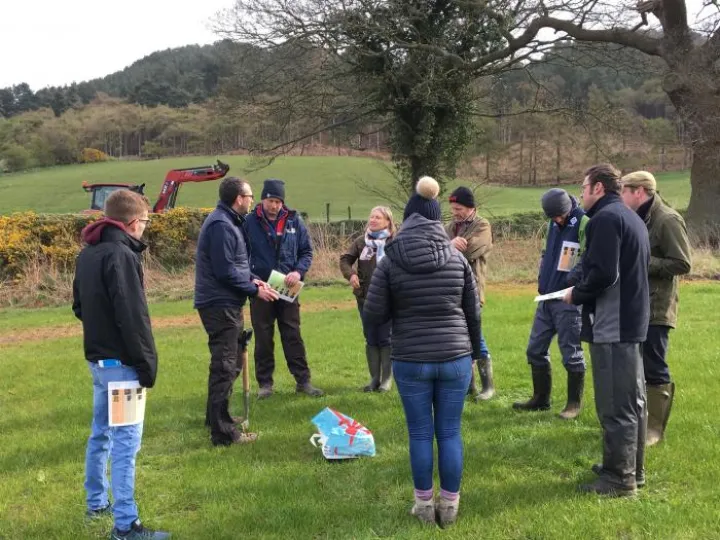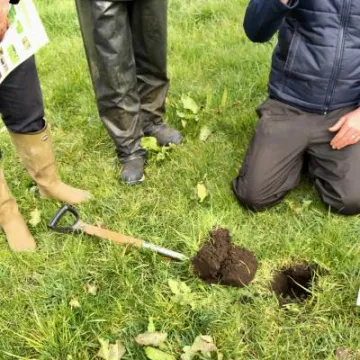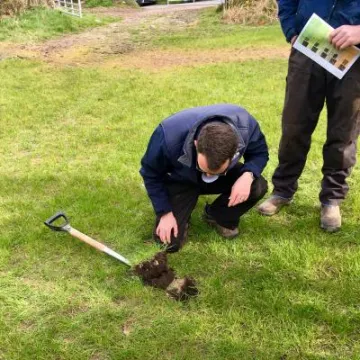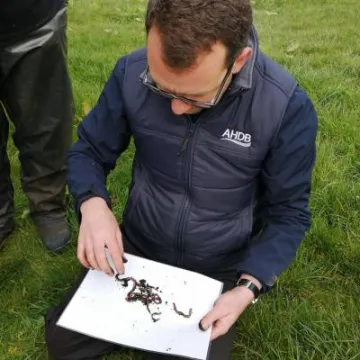The Answer Lies in the Soil
Managing Soil Fertility Workshop – Report by Dr Nicola Hall.
On a very cold Monday morning on 1 April we met at Bankhead Farm, courtesy of Alistair Cliff and Farm Manager, James Williamson, to discuss managing soil fertility and structure for optimal forage production.
Our expert speakers from AHDB, senior soil scientist James Holmes and dairy scientist Siwan Howatson, talked us through the basics of getting soil condition and fertility right for grass growth.
We started by visiting a field reseeded last Autumn, recently taken on by the farm, with a history of heavy winter grazing and stubble turnips. The field had been ploughed in the Autumn and grass cover looked good.
Our speakers talked us through the AHDB Healthy Grassland Soils approach to assessing soil condition, which starts with a surface assessment. In this case cover was fairly good, so the next step was to dig a soil pit. James demonstrated the method of digging three sides of a square so that a spade-sized block can be carefully lifted to leave one side undisturbed.
On our first spadeful from near the gateway it was apparent that the upper 20cm or so came away with a sharp horizontal break from the underlying layers, and the block itself was dense and difficult to break apart. From further into the field we found some signs of larger blocks, but overall a more open structure with less evidence of horizontal pan.
The discussion turned to remedying compaction, with most farmers in the group having used sward lifters and sub-soilers in the past. James stressed the importance of getting the spade out every time before heading into the field, to ensure that the ground conditions are not too wet, to check the depth required to break up the pan, and mainly to check whether aeration is required at all.
The emphasis is on employing the least disturbance required on any soils, with only the most severe compaction scores of 4 or 5 potentially benefiting from intervention.
Operations in the Autumn in the right conditions are likely to have the least impact on grass yield. AHDB's Healthy Grassland Soils assessment card and grassland soils pocket book can be downloaded or ordered here by CLICKING HERE.
The next topic of the workshop was the issue of re-invigorating the tired pastures on the banks, which Alistair plans to spray out and reseed in the Spring. The issue of diversifying the forage on offer was discussed, with all agreeing that at times alternatives to Italian rye benefit the farm in terms of both palatability and drought resilience. Alistair's plan for these fields is to sow some newer varieties of festulolium which are a hybrid of ryegrass and fescue grasses, on these fields without clover as the weed burden in the field may make it necessary to control docks in particular.
Siwan referred us to AHDB's extensive resources on grass varieties, including the Recommended Grass and Clover Lists CLICK HERE and trials in conjunction with IBERS on festuloliums under the SUREROOT Project CLICK HERE, which demonstrate impressively deep rooting and resistance to soil compaction.
AHDB's Forage for Knowledge programme sends weekly updates on research outputs, and links to seasonally relevant resources, which farmers can sign up to at this web address CLICK HERE.
Lastly we spent a few minutes looking at worms, which as the most visible and measurable indicator of soil life, are a great way to benchmark the overall health of the soil. On the grassy banks, one spadeful was carefully picked apart and worms separated onto a board. We learned that in the UK, while there are over 26 species of worm, they can broadly be split into 3 families depending on where they reside within the soil.
The surface-dwellers tend to be smaller and shorter lived, often darker in colour, and eating surface litter. The more common and often paler soil dwellers mix the soil, redistributing soil bacteria and producing faeces (casts) rich in nutrients (N, P, K, S). The larger worms we find in the soil, which are those we most highly prize for improving porosity, aeration and water infiltration in soils, burrow deep into the soil and can create vertical channels up to 2m in depth, pulling surface litter deep into the soil. These are the longest lived at up to 10 years, and with the longest life cycle, also the most sensitive to disturbance. These worms are often absent from fields managed with intensive cultivations.
AHDB have produced an excellent earthworm guide CLICK HERE.
James recommends an annual worm count in the Autumn, following the method of NERC Soil Security Fellow Jackie Stroud, who launched the 60 Minute Worm Count method in 2018 in response to a call for more effective but simpler measures of soil health, that anyone can implement with only a little guidance and time needed. Surveys to date indicate a healthy average of around 9 worms per spadeful, and it was very pleasing to find that our single spadeful at Bankhead Farm produced at least 8 worms including all three worm types.

Sandstone Ridge Trust
Registered Company No. 7673603
Registered Charity No. 1144470
info@sandstoneridge.org.uk





